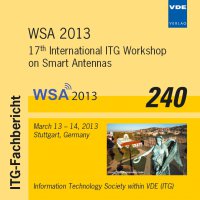Search-Based MUSIC Techniques for 2D DoA Estimation Using EADF and Real Antenna Arrays
Conference: WSA 2013 - 17th International ITG Workshop on Smart Antennas
03/13/2013 - 03/14/2013 at Stuttgart, Deutschland
Proceedings: WSA 2013
Pages: 8Language: englishTyp: PDF
Personal VDE Members are entitled to a 10% discount on this title
Authors:
Schulz, Dominik; Thomae, Reiner S. (Electronic Measurement Research Laboratory, Ilmenau University of Technology, 98693 Ilmenau, PO 100565, Germany)
Abstract:
The aim of this paper is to show, how direction of arrival (DoA) estimation can be done for real antenna arrays. To this end, we review practical search-based MUSIC techniques. These techniques can be divided into two categories: The first category of algorithms needs to jointly estimate the polarization vector while the second group of algorithms does not need to estimate the state of polarization. In order to perform high resolution 2D DoA estimation (azimuth and elevation) we assume that the antenna array has been calibrated in an anechoic chamber. The result is a sampled version of the real 2D polarimetric array manifold. The Effective Aperture Distribution Function (EADF) is used to interpolate between the measurement points. Hence, the MUSIC spectrum and its gradients can be evaluated for arbitrary values of azimuth, elevation and for different states of polarization. In our work, we apply the mentioned algorithms to an Lquad antenna array with seven ports and compare the results in terms of accuracy and in terms of the amount of iterations needed. Additionally, we show the Cramér-Rao Lower Bounds for the estimation of elevation angle and azimuth arc length.


